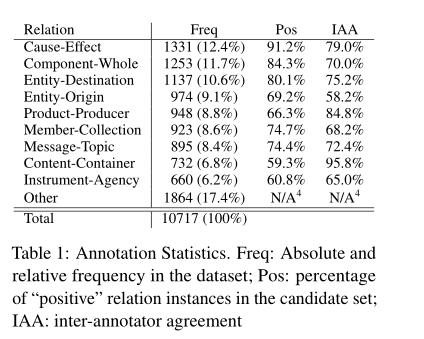提供者:卢梦依
下载地址:http://semeval2.fbk.eu/semeval2.php?location=data
简介
数据集概述
SemEval-2010的任务8关注的是两个名词之间的语义关系。例如,茶和人参是在“从德里人参的杯子里”的一种物质来源关系中。语义关系的自动识别有许多应用,如信息提取、文档摘要、机器翻译、词汇和语义网络的构建等。它还可以促进辅助任务,如wordsense消除歧义、语言建模、语法分析和识别文本蕴涵。
有9种关系如下所示:
Cause-Effect (CE).An event or object leads to an effect. Example: those cancers were caused by radiation exposures.因果关系
Instrument-Agency (IA). An agent uses an instrument. Example: phone operator
Product-Producer (PP).A producer causes a product to exist. Example: a factory manufactures suits 生产与被生产的关系
Content-Container (CC).An object is physically stored in a delineated area of space. Example:a bottle full of honey was weighed 容器与内容物的关系
Entity-Origin (EO).An entity is coming or is derived from an origin (e.g., position or mate-rial) Example:letters from foreign countries 实体来自或源自原产地(例如,位置或材料)
Entity-Destination (ED).An entity is moving towards a destination. Example: the boy went to bed 一个实体正在向目的地移动。 例如:男孩去睡觉
Component-Whole (CW).An object is a component of a larger whole. Example: my apartment has a large kitchen 组件到整体
Member-Collection (MC).A member forms anonfunctional part of a collection. Example:there are many trees in the forest 成员集合关系(MC),成员构成集合的非功能部分。 例如:森林里有很多树
Message-Topic (MT).A message, written or spoken, is about a topic. Example: the lecture was about semantics 。信息与主题 例如:讲座是关于语义的。
各占比例如下图:

文件
类型:txt文本
train data: 1370KB
test data: 342KB
文件格式:”The
相关论文
1.Zeng D, Liu K, Chen Y, et al. Distant Supervision for Relation Extraction via Piecewise Convolutional Neural Networks[C]// Conference on Empirical Methods in Natural Language Processing. 2015:1753-1762.
2.Cai R, Zhang X, Wang H. Bidirectional Recurrent Convolutional Neural Network for Relation Classification[C]// Meeting of the Association for Computational Linguistics. 2016:756-765.
3.Miwa M, Bansal M. End-to-End Relation Extraction using LSTMs on Sequences and Tree Structures[J]. 2016.
4.Zhou P, Shi W, Tian J, et al. Attention-Based Bidirectional Long Short-Term Memory Networks for Relation Classification[C]// Meeting of the Association for Computational Linguistics. 2016:207-212.